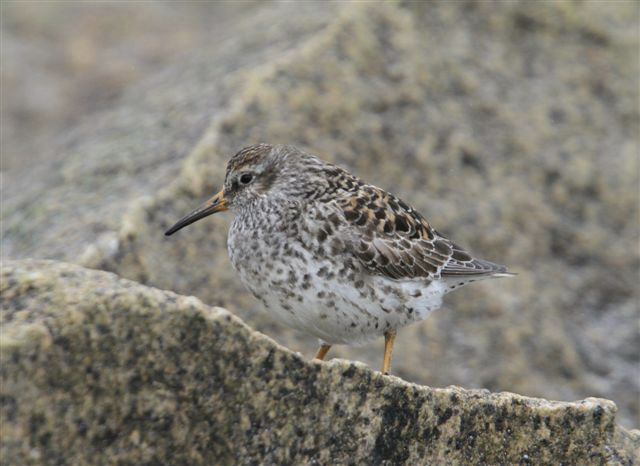Wayne R. Petersen

Wayne R. Petersen
This issue's mystery species is obviously a shorebird. The bird's long, slender, and pointed bill suggests that it is a sandpiper of some kind. A plover, in contrast, would have a short, blunt bill. The bird's heavily patterned and spotted underparts further suggest that the bird is a sandpiper, because a plover would have either plain or banded underparts.
Sandpipers in the Family Scolopacidae are typically small and slim shorebirds, often streaked below, and frequently with streaked or strongly patterned upperparts, especially in breeding plumage. The legs may be either dark or light in color. Many sandpiper species also exhibit fine bills that are straight and uniformly dark in color. The mystery sandpiper's characteristics differ from most sandpipers in that it has a relatively long, slightly curved bill that appears bicolored at the base, and it also has a robust, chunky shape. Especially notable on the pictured sandpiper are prominent dark spots on the white lower belly. Few sandpipers other than the atypical Spotted Sandpiper have such prominent spots on their underparts in combination with light-colored legs and a strongly colored bill. A Spotted Sandpiper, however, would present a more even-textured appearance to the back and its longer tail projects beyond the folded wing tips. A Spotted Sandpiper also would not have the dark-centered and pale-fringed scapulars and back feathers, streaked appearance of the throat, or pale fringes to the greater coverts on the wing shown by the mystery bird.
The overall appearance and impression (jizz) of the mystery shorebird is that of a somewhat long-billed, chunky sandpiper with pale-colored legs. When these features are combined with the fact that the shorebird is standing on what appears to be a granite rock, the collective impression points to an adult Purple Sandpiper (Calidris maritima) in breeding plumage. Massachusetts birders don't often get to see Purple Sandpipers at close range and see them even less often in breeding plumage. Most Purple Sandpipers are seen on offshore, wave-washed rocks in midwinter where obtaining good looks at close range is often challenging.
Purple Sandpipers are essentially winter shorebirds that prefer offshore, algae-covered rocks where they forage in the barnacle zone between waves, which often require them to frequently fly about to avoid being washed off their favored feeding rocks. Exclusively a coastal species, they usually arrive in late October at their favored wintering localities around Cape Ann, the outer islands in Boston Harbor, Cohasset and Scituate on the South Shore, and rocky islands off the South Coast. The birds depart by mid-May, which is the month when local observers have the best chance of seeing them in breeding plumage.
The author photographed this Purple Sandpiper in breeding plumage in Plymouth, Massachusetts, on May 15, 2011.
Wayne R. Petersen